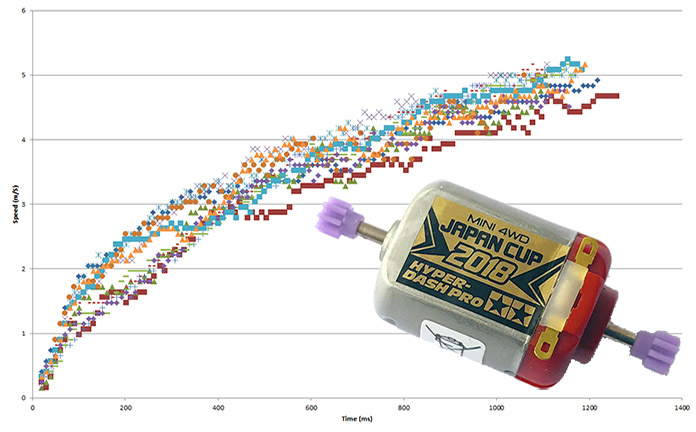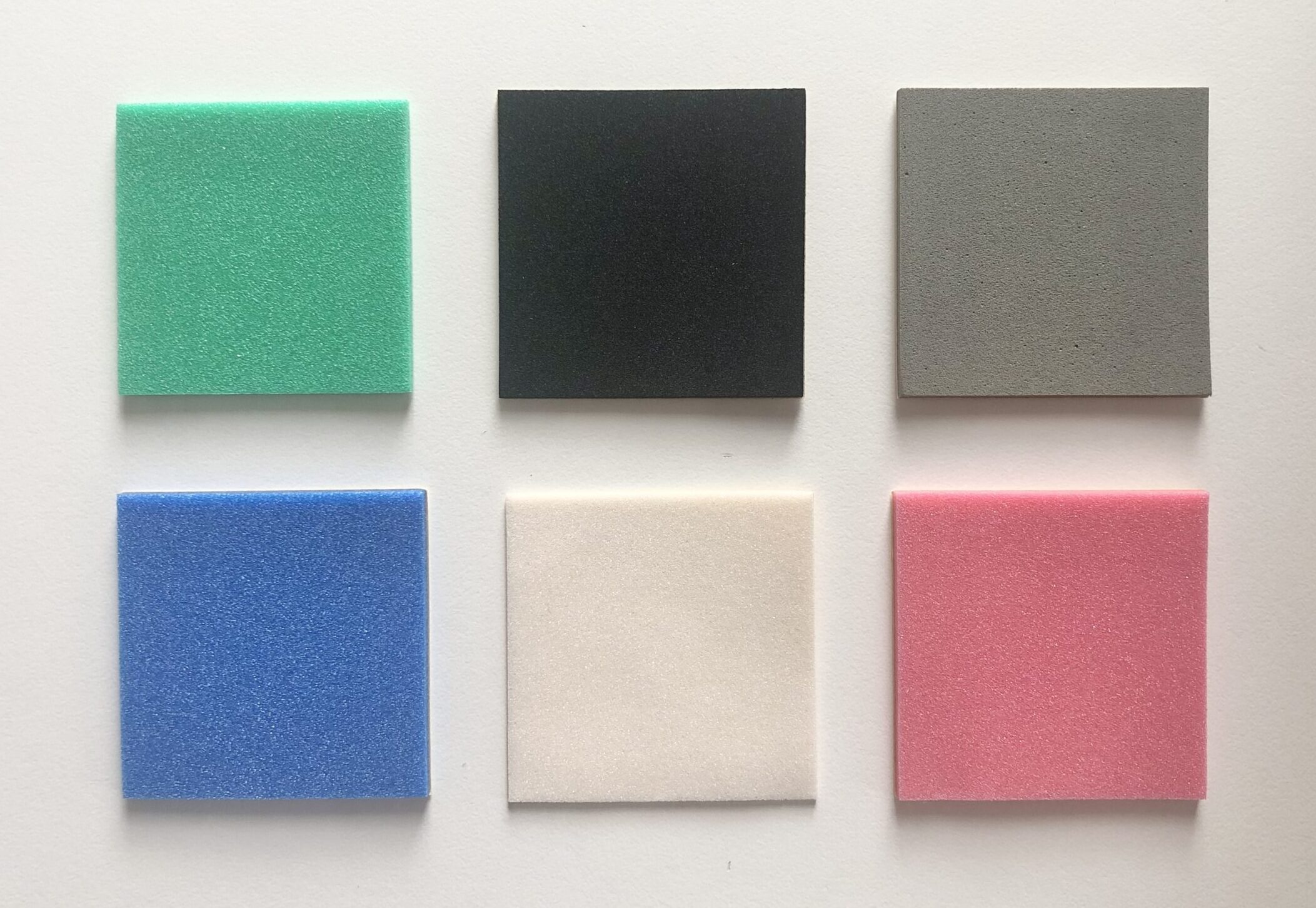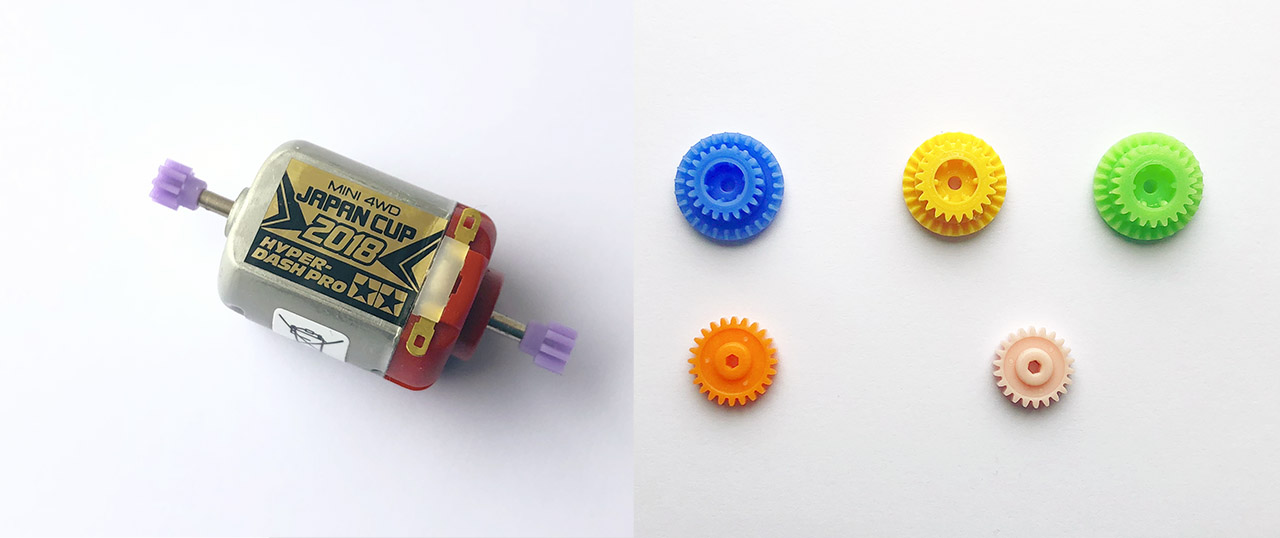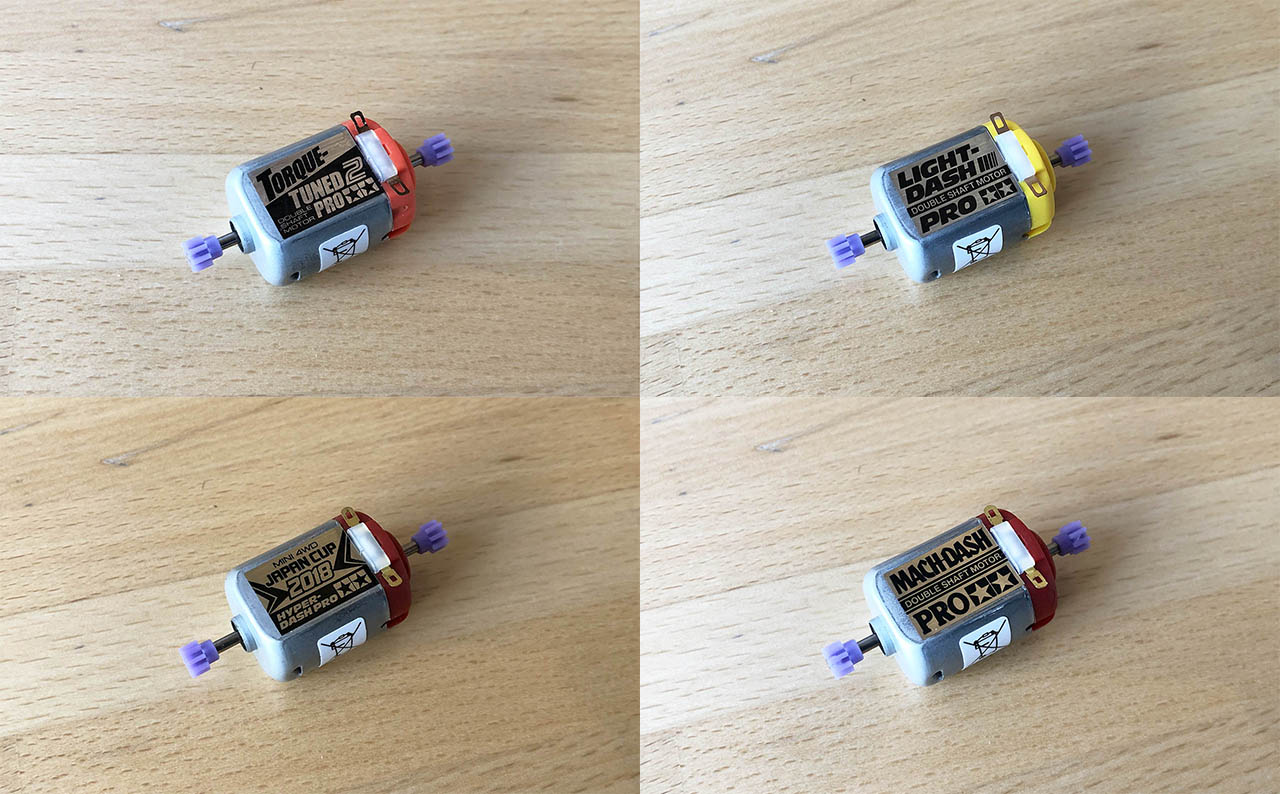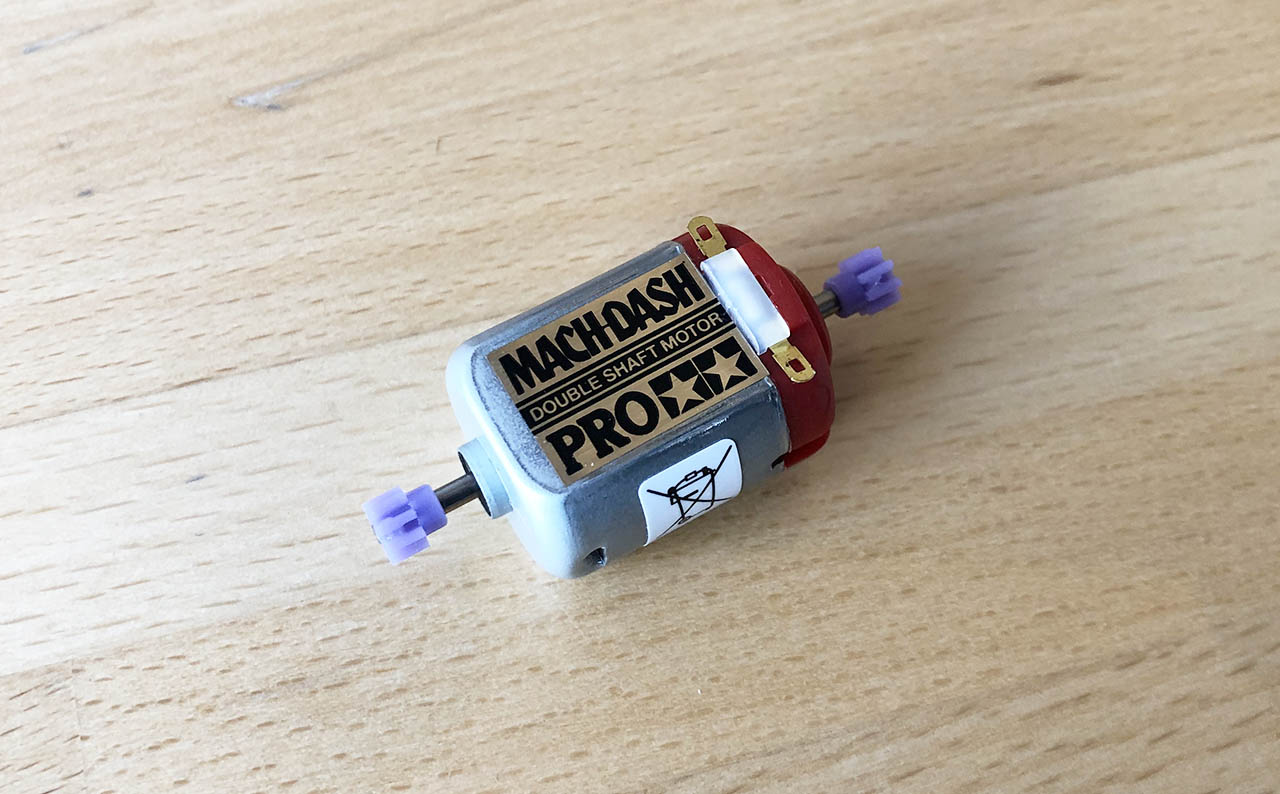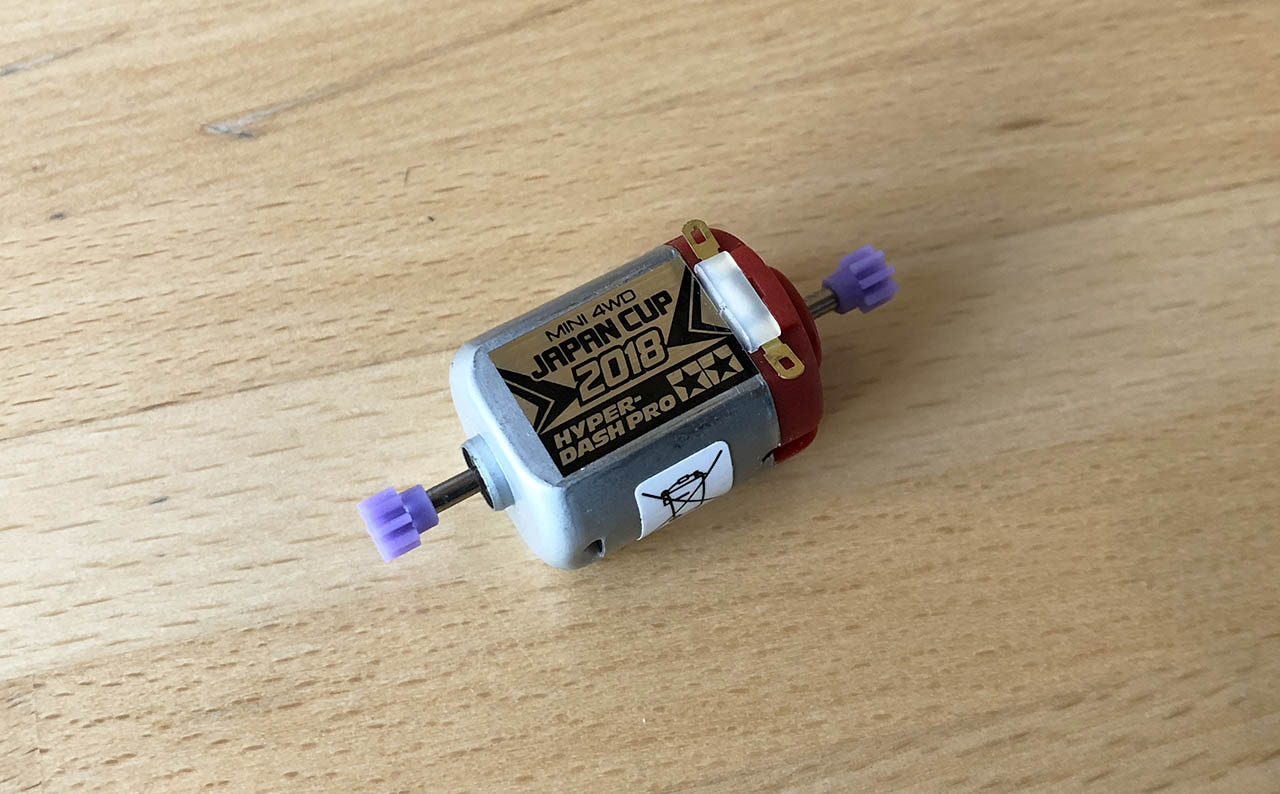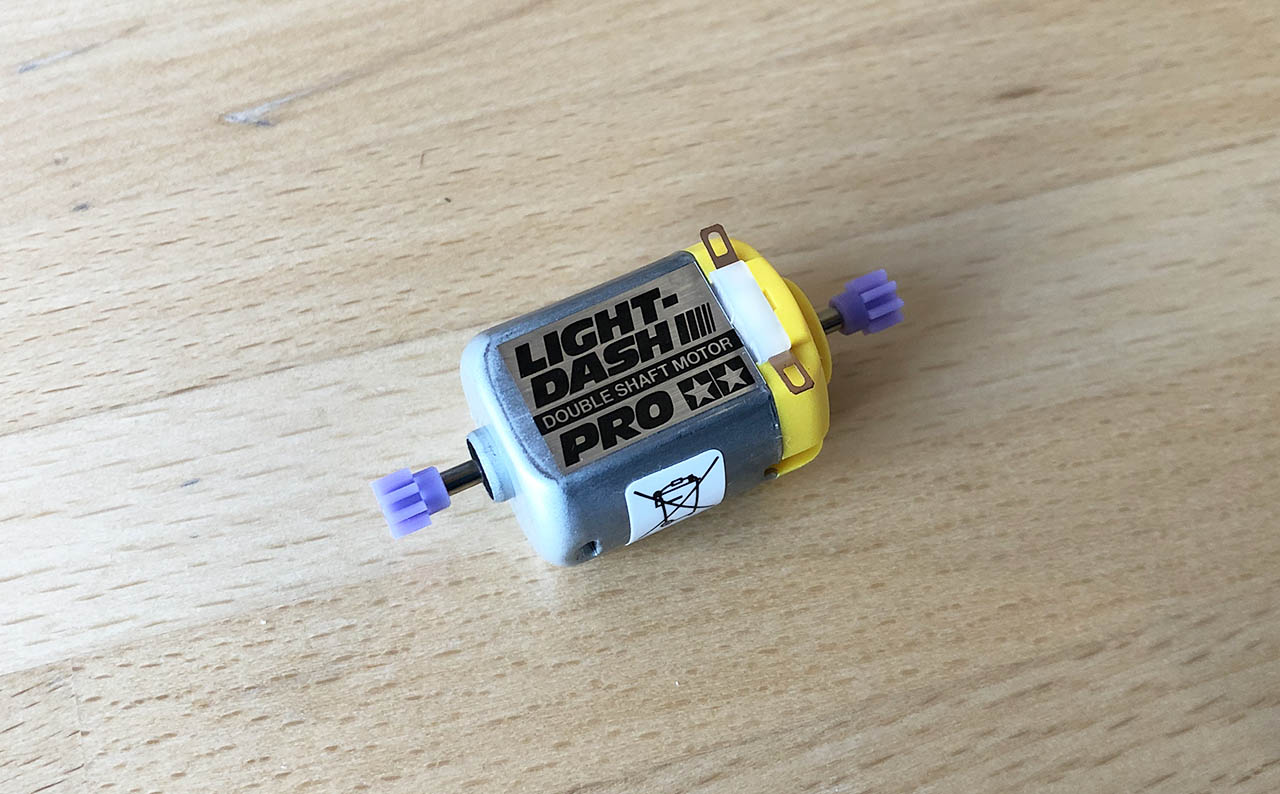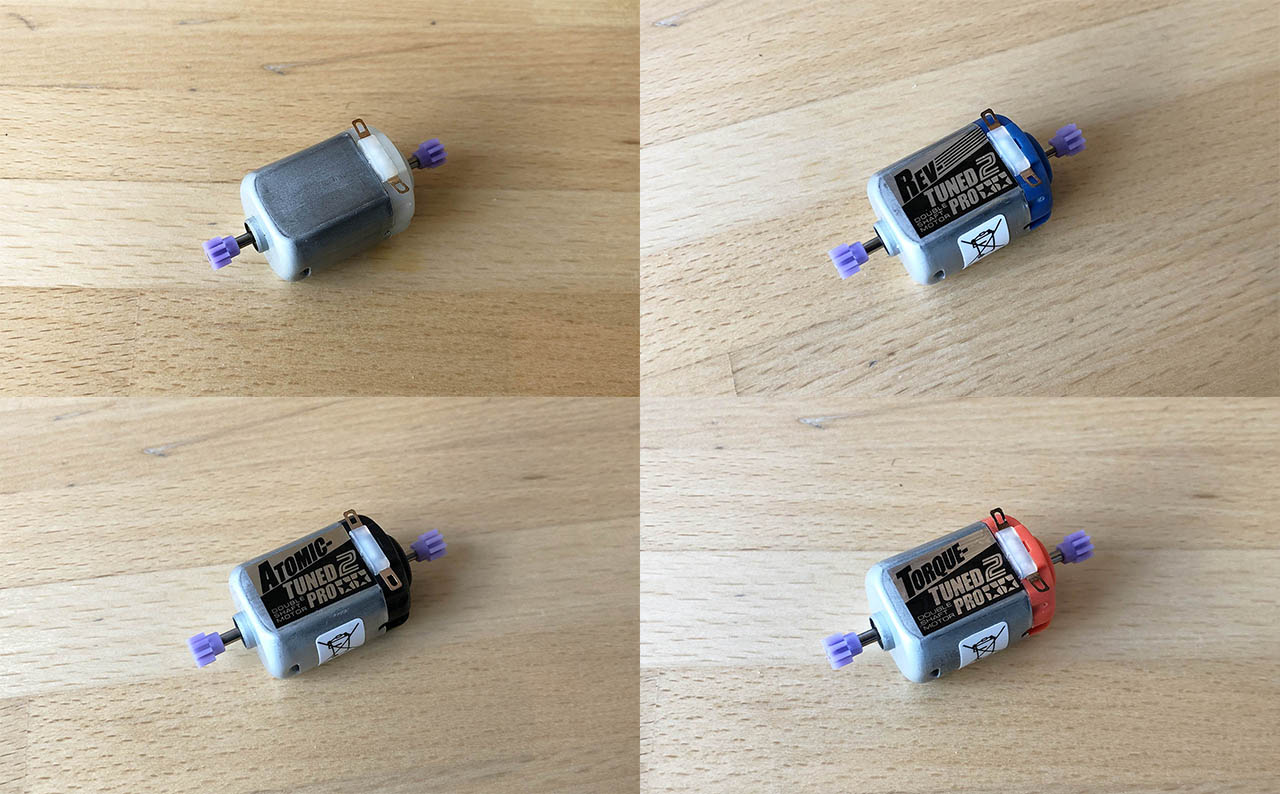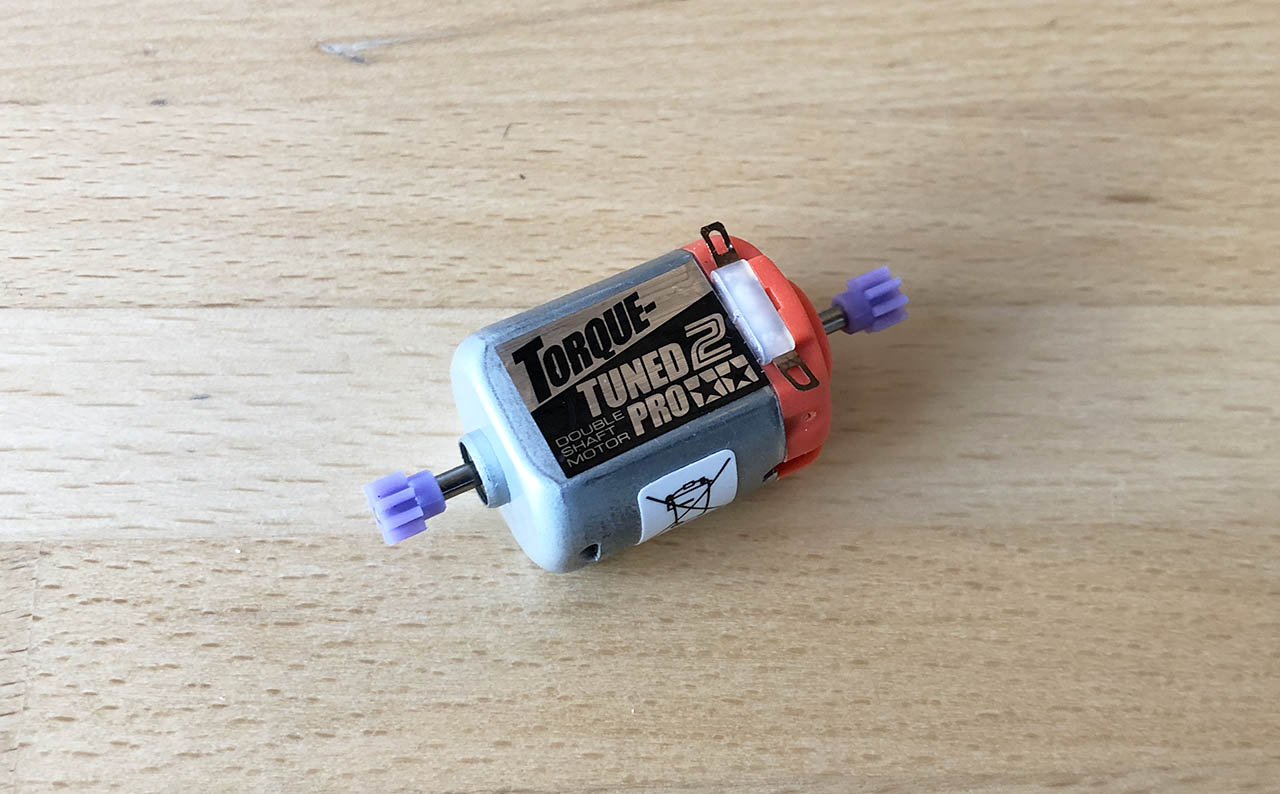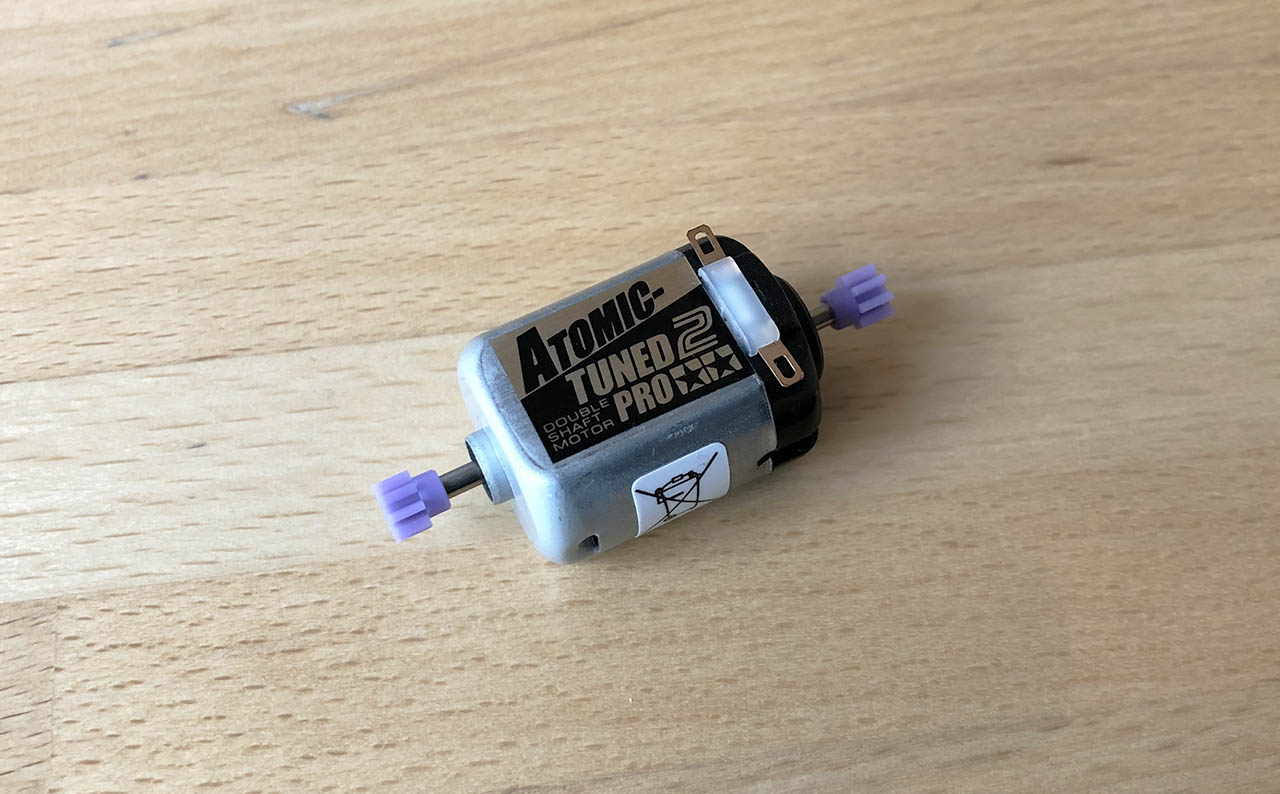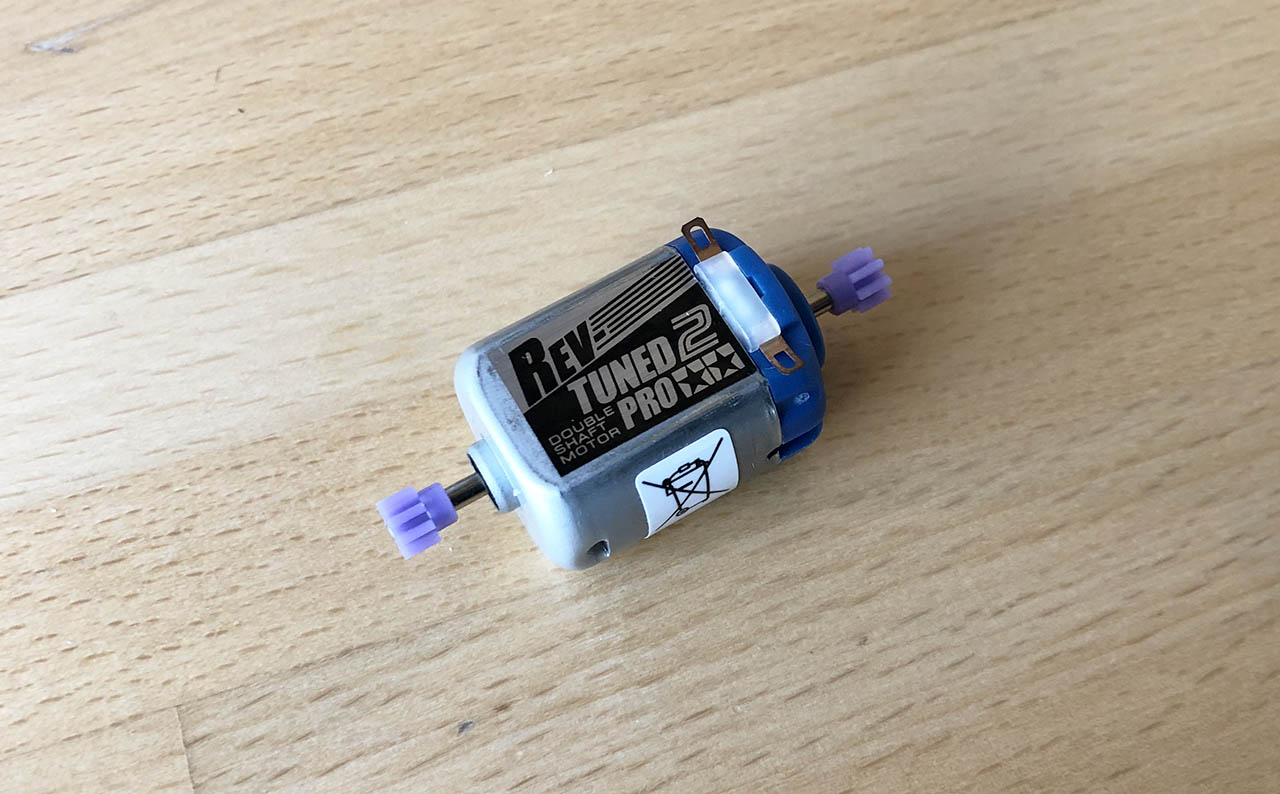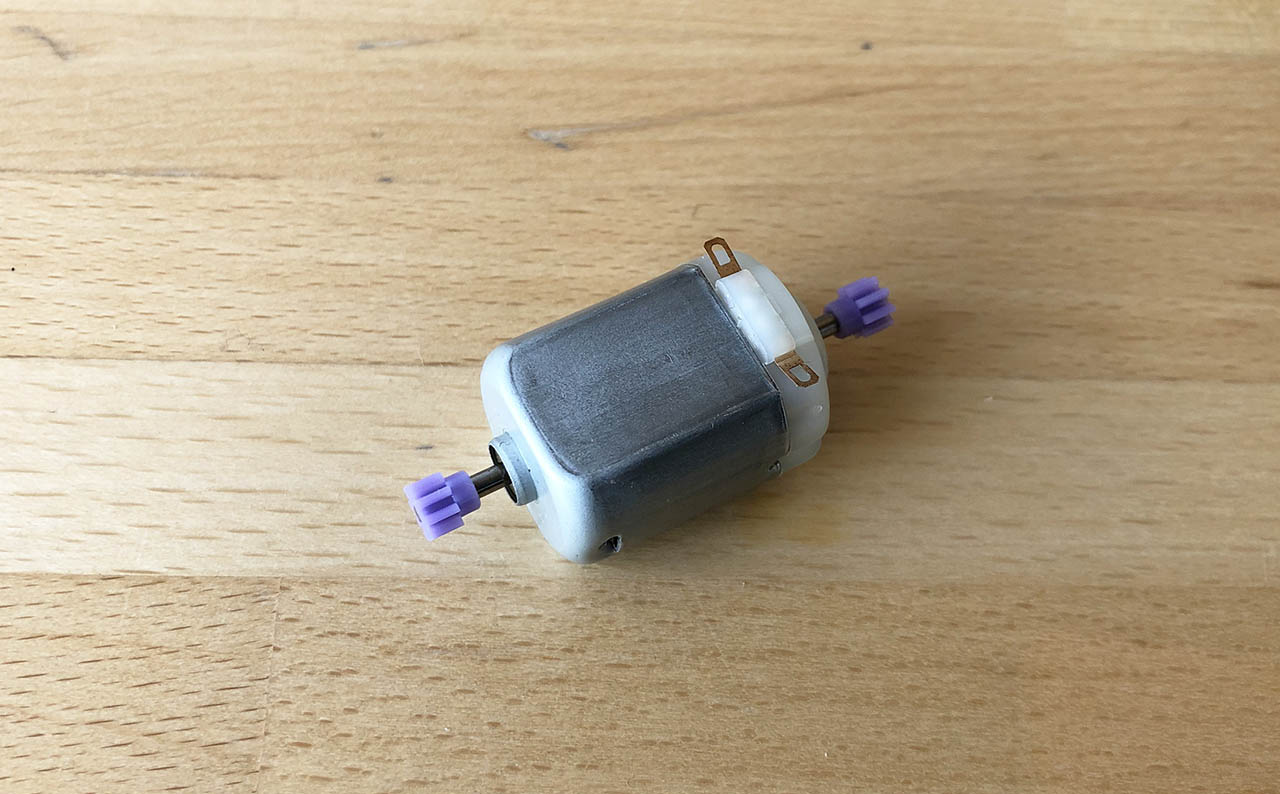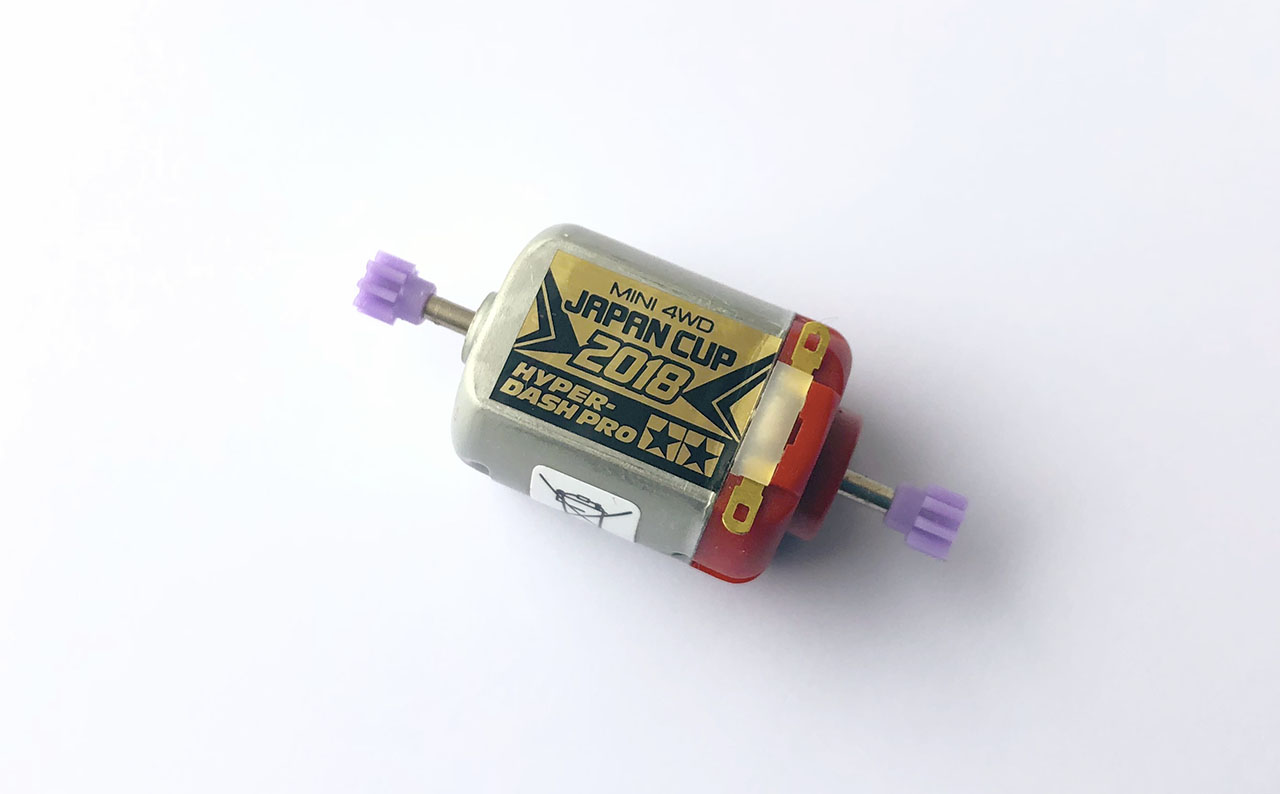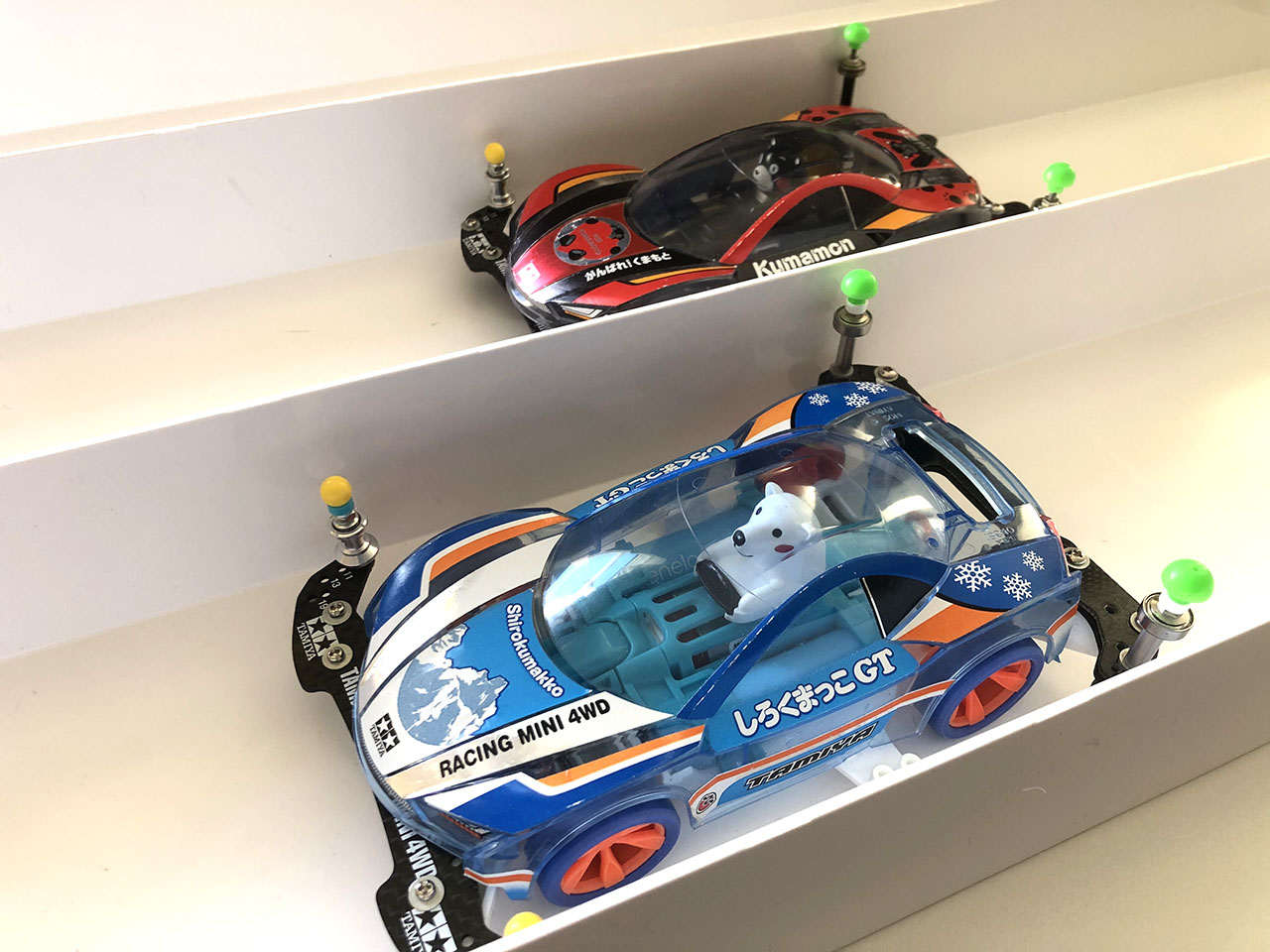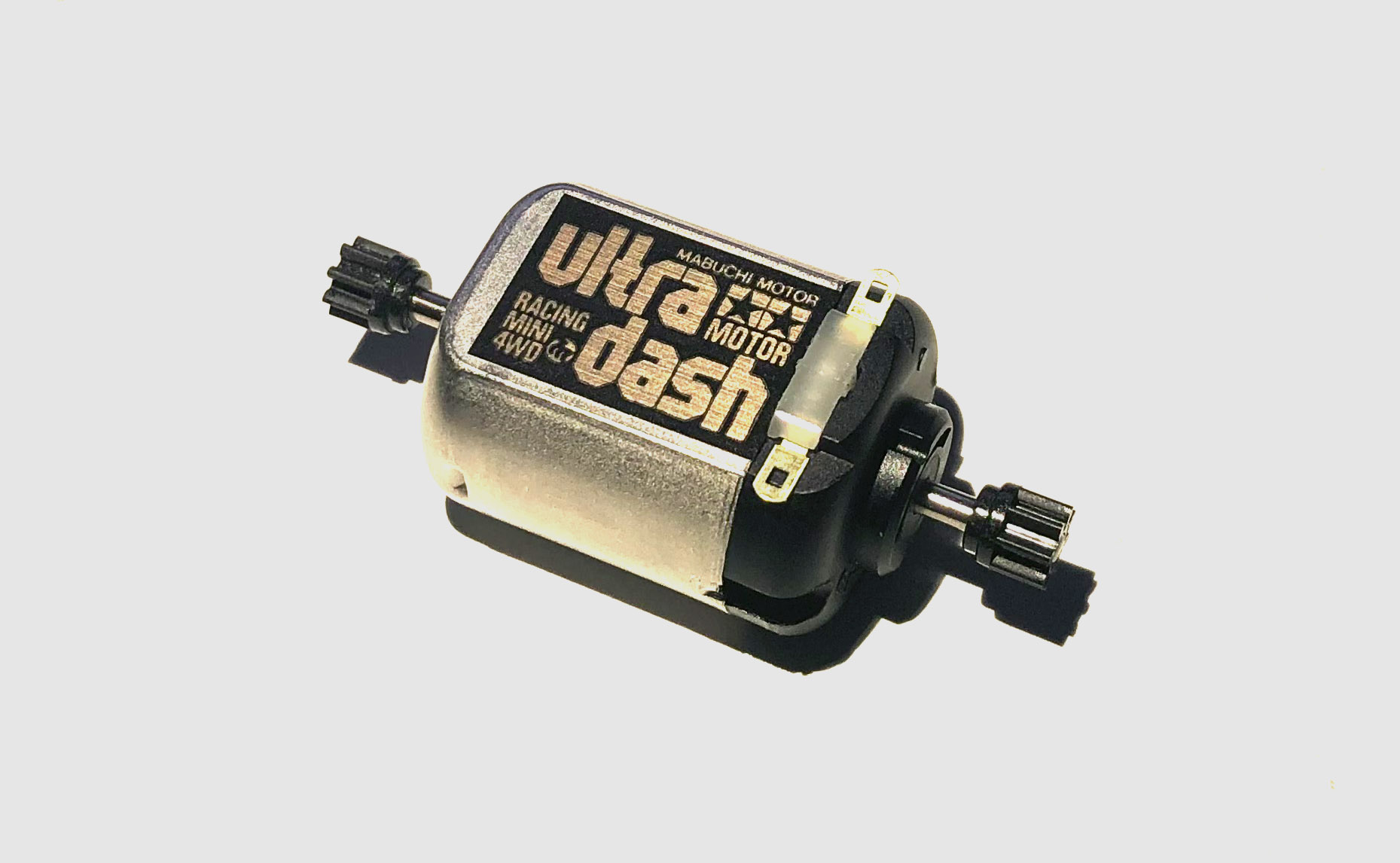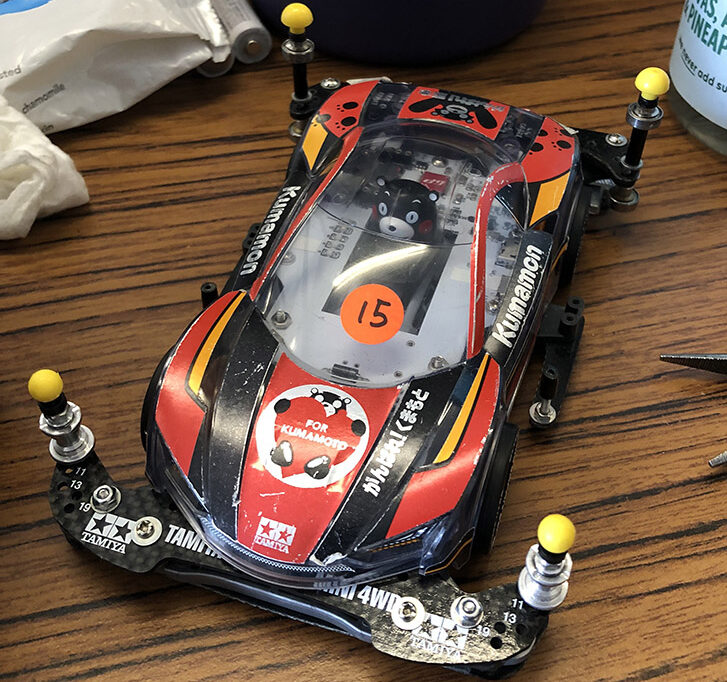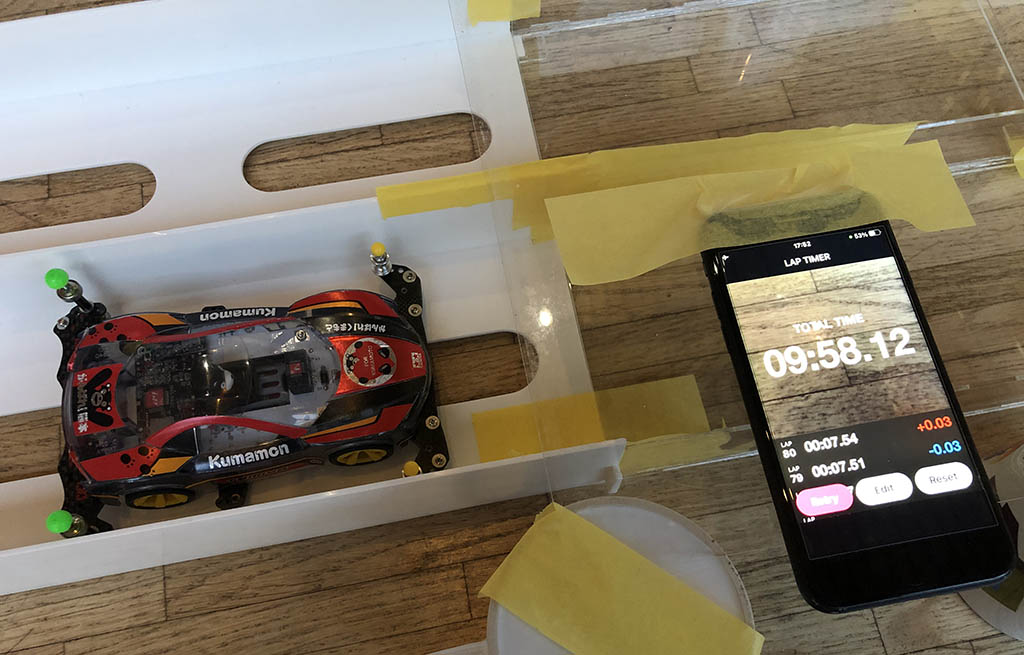First published 22 February 2023. Last updated 23 February 2023.
Introduction
We have recently tested all seven Tamiya Mini 4WD PRO motors. Let's do a side by side comparison to find out which one is the best among the seven. For full detail report on each motor, please refer to previous articles (see links below).
This is part of the PRO motor test series. We are testing all seven PRO motors: Stock PRO, Rev-Tuned 2 PRO, Atomic-Tuned 2 PRO, Torque-Tuned 2 PRO, Light-Dash PRO, Hyper-Dash PRO and Mach-Dash PRO. A report will be written for each, followed by comparison reports (like this one, Tuned compared and Dash compared). So watch this space.
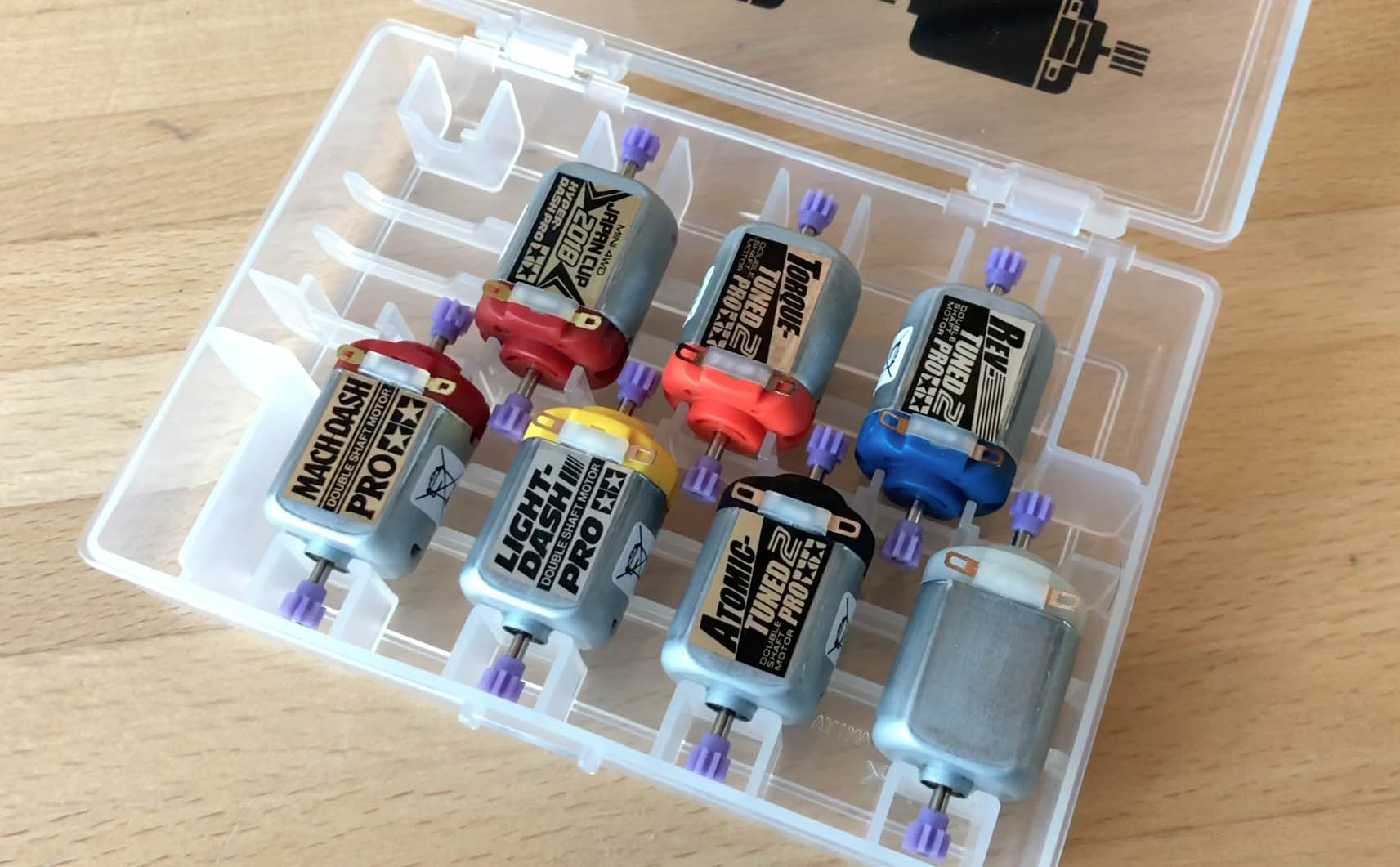
The spec
Let's remind ourselves the performance of the Tamiya PRO motors based on information from the Tamiya's Mini 4WD motor chart on the Mini 4WD Setup guide webpage:
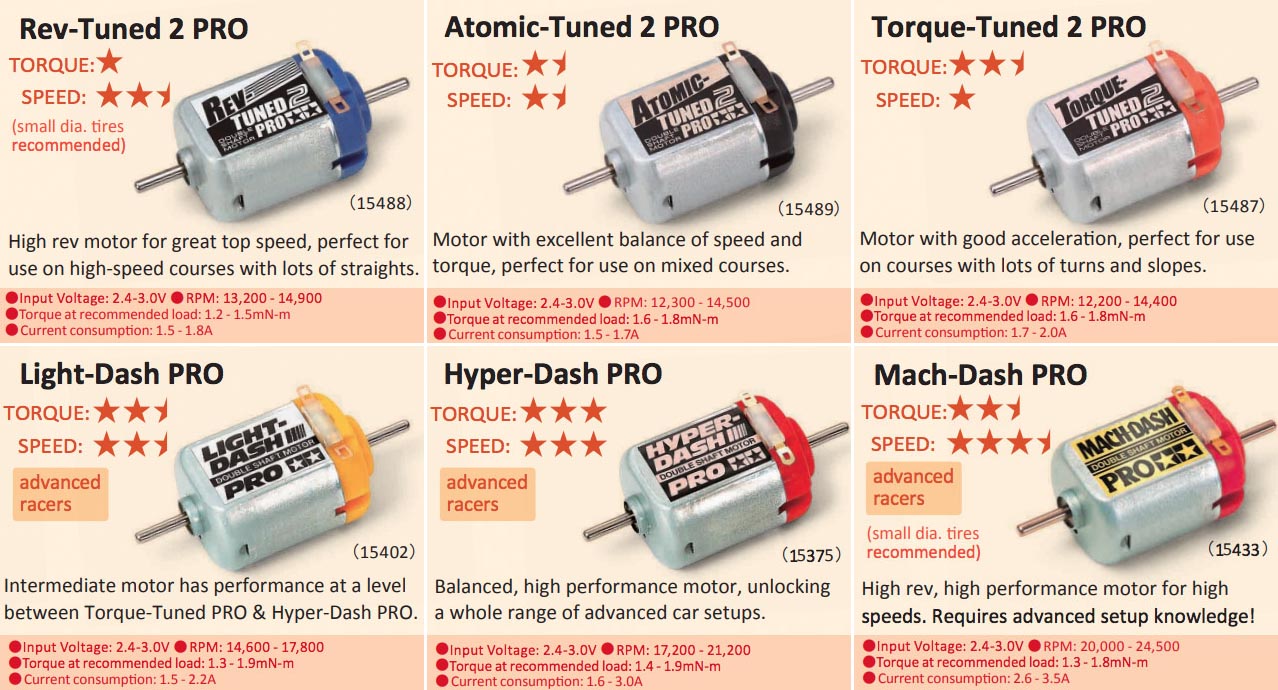
| Stock | Rev-Tuned | Atomic-Tuned | Torque-Tuned | Light-Dash | Hyper-Dash | Mach-Dash | |
| Torque at recommended load (mNm) | unknown | 1.2 - 1.5 | 1.6 - 1.8 | 1.6 - 1.8 | 1.3 - 1.9 | 1.4 - 1.9 | 1.3 - 1.8 |
| RPM | unknown | 13,200 - 14,900 | 12,300 - 14,500 | 12,200 - 14,400 | 14,600 - 17,800 | 17,200 - 21,200 | 20,000 - 24,500 |
Since there is no official information about the stock (kit standard) motor. We will leave it as "unknown" as before.
Test track, method and equipment
A quick recap on how we test the motors.
The track: We tested the car in our two lanes Tamiya Mini 4WD Oval home circuit with extensions to make a bigger track with longer straights. We removed the bridge crossing. We only used the outer lane to run the experiments. Based on Tamiya's information, we calculated that the length of the circuit was ~8.66 metres long.
The method: We ran our test car around the circuit in clockwise direction, starting from the start grid (see car position below). We ran three runs per motor and each run lasted 30 seconds. The batteries was fully re-charged before each run. The motor was given enough time to cool down to avoid performance loss.
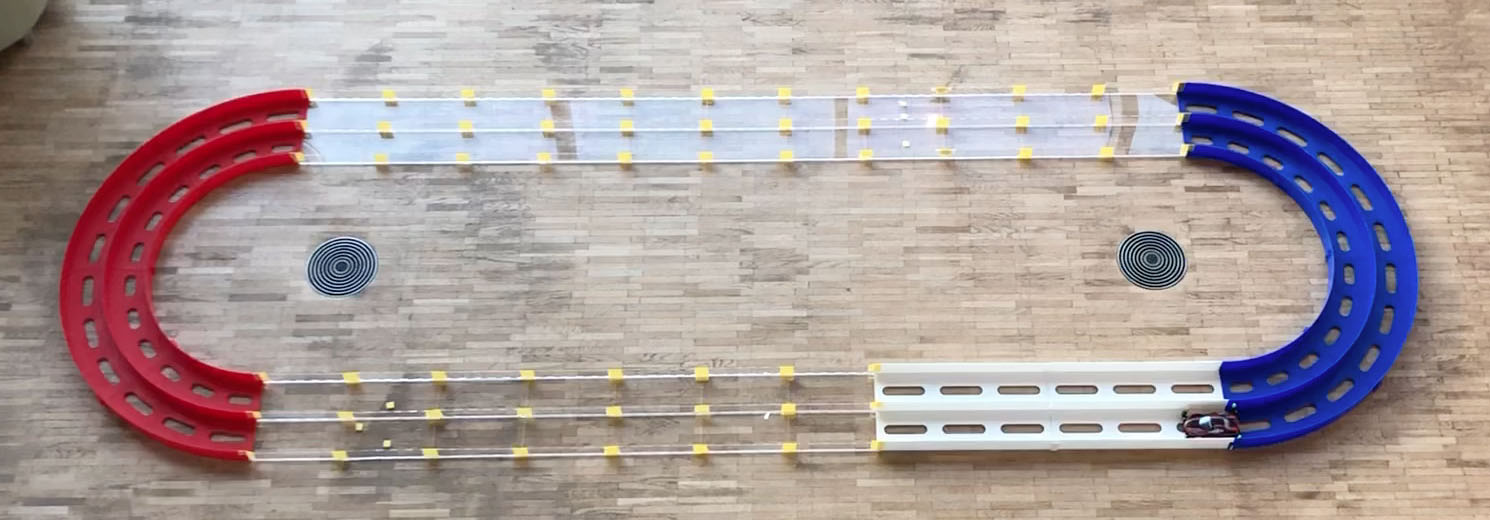
The equipment: We used our Mini 4WD development prototype based on MA chassis with telemetry data recording capability powered by ARM Cortex M0 48Mhz processor (Arduino Zero) to record data in an on-board data storage device. After every run, we downloaded the data (in CSV format) from the on-board computer and analysed the results with our analytic web app and Microsoft Excel.
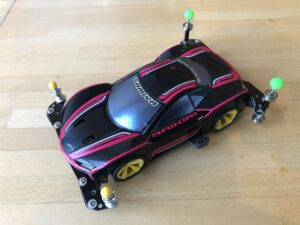
For more information, please check the full reports e.g. Stock PRO, Rev-Tuned 2 PRO, Atomic-Tuned 2 PRO, Torque-Tuned 2 PRO, Light-Dash PRO, Hyper-Dash PRO and Mach-Dash PRO.
Top speed comparison
Let's compare the top speed of the seven motors in car speed (m/s).
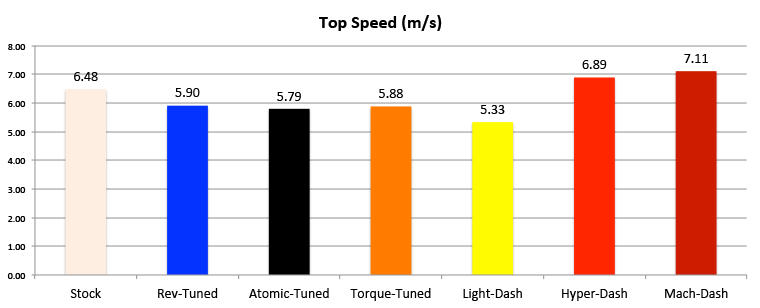
Our Mach-Dash PRO motor has the highest top speed at 7.11 m/s on average based on the result from three runs, followed by Hyper-Dash PRO at 6.89 m/s. The surprise is that our Stock (kit-standard) PRO came third at 6.48 m/s beating the Tuned motors. The slowest is Light-Dash PRO at 5.33 m/s.
Average speed comparison
Let's compare the average speed of the seven motors in car speed (m/s).
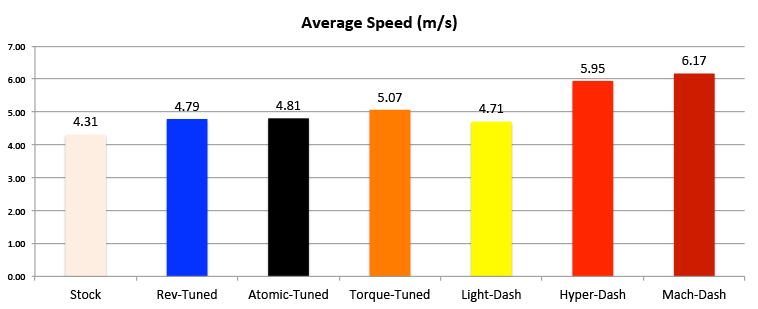
Our Mach-Dash PRO motor is still the king with the highest top speed at 6.17 m/s on average based on the result from three runs, followed by Hyper-Dash PRO at 5.89 m/s. Our Torque-Tuned 2 PRO came third at 5.07 m/s. All tuned motors were faster than Light-Dash PRO. This time Stock (kit standard) PRO is the slowest of all seven at 4.31 m/s.
Motor torque comparison
Let's compare the motor torque of the seven motors.
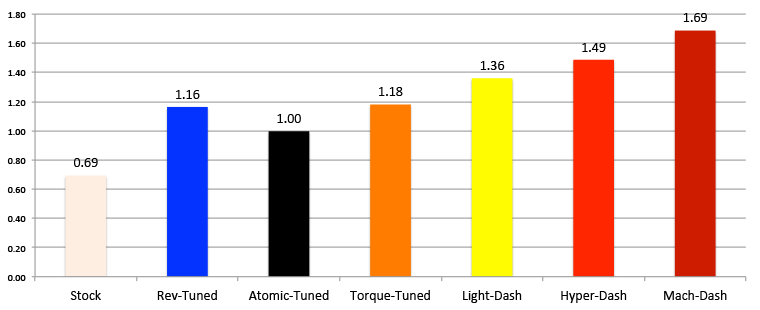
Our Mach-Dash PRO motor has the highest torque at 1.69 mNm on average based on the result from three runs, followed by Hyper-Dash PRO at 1.49 mNm and Light-Dash PRO at 1.36 mNm. All our Tuned PRO motors have less torque than our Dash PRO motors. Our Stock PRO motor has the least torque at 0.69 mNm.
Top speed and average speed compared
Let's put the top speed and average speed figures (motor RPM) in one chart and see what we can discover.
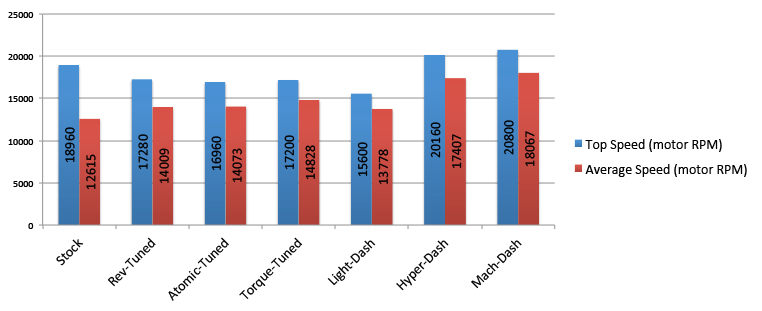
Our Stock Pro (kit standard) has the highest top speed, yet it has the slowest average speed, the variation is large. Whereas our Light-Dash PRO motor has the smallest difference between top speed and average speed.
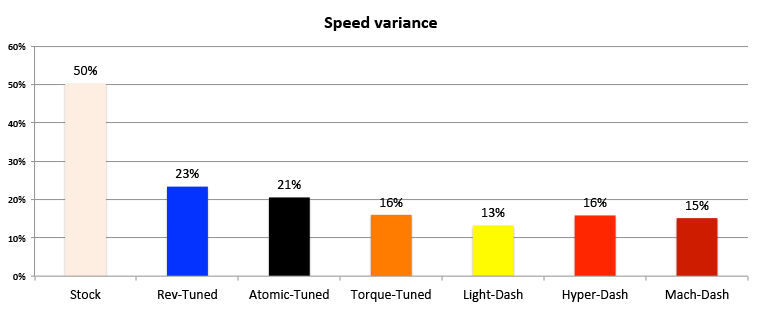
It is more clear when we calculate the variance in percentage i.e. (top speed - average speed) / average speed × 100% and plot a chart as above.
Higher variance will make it harder to control the speed over an obstacle. So if you want the most consistent performance, it seems like the Light-Dash PRO motor is the best amongst the PRO motors.
How do they compare with Tamiya's recommendation?
Here is an extract of the performance graph from Tamiya's website.
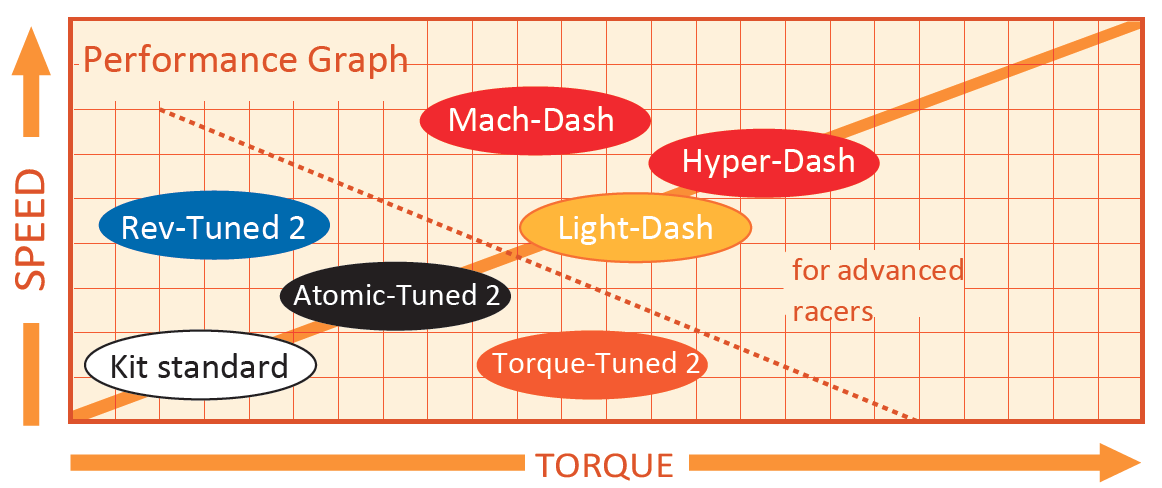
The graph gives the impression that for tuned motors, the Rev-Tuned 2 motor gives you more speed, Torque-Tuned 2 motor gives you the most torque (acceleration) and Atomic-tuned 2 motor gives you the balance of the two. Stock PRO (kit standard) gives you the least performance. And there is an impression of a linear progression of performance from Stock (kit standard), to Atomic-Tuned, to Light-Dash and to Hyper-Dash, while Mach-Dash is a higher speed and lower torque version of Hyper-Dash.
Let's plot our result in a similar format and see what we can discover:
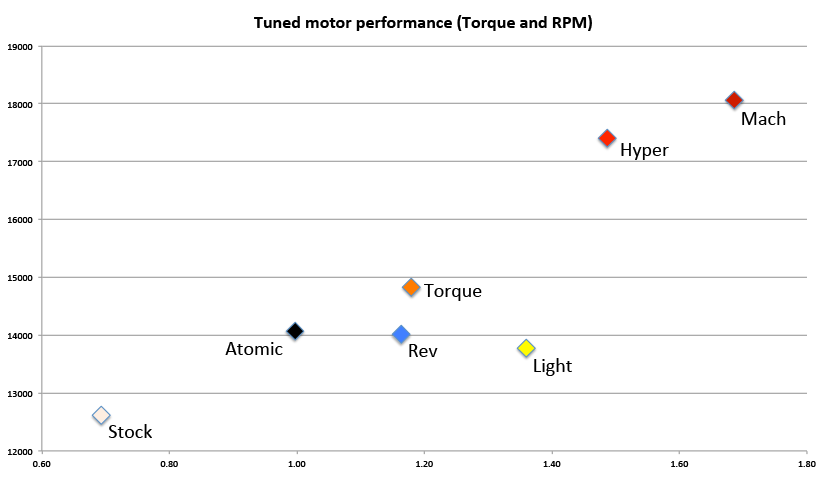
X-axis is motor torque (mNm) and Y-axis is motor RPM.
The diamond dots are the results based on our measurements (average running speed and motor torque from standstill). The colour are related to the colour of the bell cap of the motor, i.e. stock (in beige), rev-tuned (in blue), atomic-tuned (in grey) and torque-tuned (in orange), light-dash (in yellow), hyper-dash (in bright red) and mach-dash (in dark red).
From our results, we didn't get exactly the same performance pattern as stated in Tamiya's information. We can see a "kind of" linear performance progression from Stock (kit standard) to Atomic-Tuned, then to Torque-Tuned and Hyper-Dash and finally Mach-Dash. The tuned motors are not positioned similarly as illustrated.
Let's compare our measurements with Tamiya's spec one more time.
| Stock | Rev-Tuned | Atomic-Tuned | Torque-Tuned | Light-Dash | Hyper-Dash | Mach-Dash | |
| Torque at recommended load (mNm) | unknown | 1.2 - 1.5 | 1.6 - 1.8 | 1.6 - 1.8 | 1.3 - 1.9 | 1.4 - 1.9 | 1.3 - 1.8 |
| RPM | unknown | 13,200 - 14,900 | 12,300 - 14,500 | 12,200 - 14,400 | 14,600 - 17,800 | 17,200 - 21,200 | 20,000 - 24,500 |
| Motor Torque from standstill (mNm) | 0.69 | 1.16 | 1.00 | 1.18 | 1.36 | 1.49 | 1.69 |
| Average Speed (motor RPM) | 12,615 | 14,009 | 14,073 | 14,828 | 13,778 | 17,407 | 18,067 |
We are going to compare our measured average speed with RPM from Tamiya and our motor torque from standstill with torque at recommended load from Tamiya. Since we don't know how Tamiya measured and made those claims, we don't have a 100% like-to-like comparison. But what we have done is a start. We have to start somewhere, right?
To make it easier to visualise, we have coloured the figures according to whether they are on spec or off spec. On spec in green and off spec in red.
For tuned motors, motor RPM figures are on spec while the motor torque figures are off.
For dash motors, motor torque figures are on spec while only one RPM figure is on spec.
How do they compare with popular believes?
Here is some information from fandom.com
Rev-Tuned: "As its name implies, it is a speed-focused motor and has higher power but lower torque when compare to Torque-Tuned Motor... Due to its lower torque, it is not recommended to use on Mini 4WD cars with large-diameter wheels and low-gear ratios." source fandom (Mini4Science: our Torque-Tuned has higher speed than Rev-Tuned)
Atomic-Tuned: "It sits between the speed-focused Rev-Tuned Motor and the acceleration-focused Torque-Tuned Motor. While both the power and torque of the motor are a little bit inferior than the aforementioned tuned motors, it is suitable for race tracks that requires both power and torque performance if the use of Hyper-Dash Motor is impossible due to course layout." source fandom (Mini4Science: our Atomic-Tuned is the slowest among the tuned motors)
Torque-Tuned: "it is a torque-focused motor and has higher torque but lower power when compare to Rev-Tuned Motor." source fandom (Mini4Science: our Torque-Tuned has higher torque and speed than Rev-Tuned)
Light-Dash: "The Light-Dash Motor is a balance-type motor that sits between the Atomic-Tuned Motor and the Hyper-Dash Motor in terms of performance characteristic. While the revving performance of the motor is similar to that of the Rev-Tuned Motor..." source fandom (Mini4Science: our Light-Dash doesn't quite sit between our Atomic-Tuned and Hyper-Dash motor)
Hyper-Dash: "All Hyper-Dash Motors are performs better than Rev-Tuned Motor and Light-Dash Motor on revving but has medium torque performance compared to the torque-based motors. Both HD3 and HD PRO (made by SMC Motor) use carbon brushes instead of brass brushes, allowing for longer running life." source fandom (Mini4Science: our Hyper-Dash has higher torque and speed than our Torque-Tuned motor)
Mach-Dash: "The double-shaft version is the more refined version of its single-shaft motor counterpart and behaves similar to that of Sprint Dash Motor, which explains why it can be use on official tournaments. It is also the only variant of Mach-Dash Motor that use silver carbon brushes. Because both motors has moderate torque, they are not suitable for race tracks that has very high acceleration requirement." source fandom (Mini4Science: our Mach-Dash motor has the highest torque and speed)
As you can see, our measurement does not necessarily align with popular believes. It doesn't mean the believes were wrong. We obtained our measurement based on a certain set of conditions and they are backed up by science. It would be great to examine the evidence and reason behind the popular believes so that we can improve our understanding.
In summary
We set out to find the best Tamiya Mini 4WD PRO motor and we got some interesting results:
- Speedy Stock PRO: we found that the Stock PRO motor has a surprising highest top speed, so given a very long straight track, the Stock PRO could beat the tuned motors. So don't under estimate it!
- Best tuned motor: the Torque-Tuned 2 PRO motor has the best average speed and torque. It also has the least variance in terms of top speed and average speed among the tuned motors, so it should give a more consistent performance.
- Best consistency: although Light-Dash PRO motor is the slowest among the dash PRO and even slower than Torque-Tuned 2PRO, it has the smallest top speed and average speed variance, this should give a more consistent performance when tackling tricky technical tracks where you need the car to land more consistently after each jump.
- Speed king: the Mach-Dash PRO motor has the highest top speed and average speed. It also has the highest torque. It is the fastest Tamiya Mini 4WD PRO motor. If you have the need for speed, this would be the choice.
So which one is the best Tamiya Mini 4WD PRO motor? It depends... we believe that the choice should be based on the track layout and the class of race you are in.
What does the result mean to fellow racers?
We found that the Stock PRO motor can be speedy; the best tuned motor is Torque-Tuned PRO; the most consistent motor is Light-Dash PRO and the fastest motor is Mach-Dash PRO. So which one is the best? It depends. We believe that the choice should be based on the track layout and the class of race you are in. But we hope that the experiment results will help you make an informed choice and help you to achieve better, faster and more consistent results.
The experiment results we got are by no means conclusive. Your setup might be different from ours which would create different results. But we hope that this report provides you an interesting insight to the subject matter. Happy racing!
What would you take away from this report? How would you improve it? Please feel free to leave a comment on our Facebook page @Mini4Science.

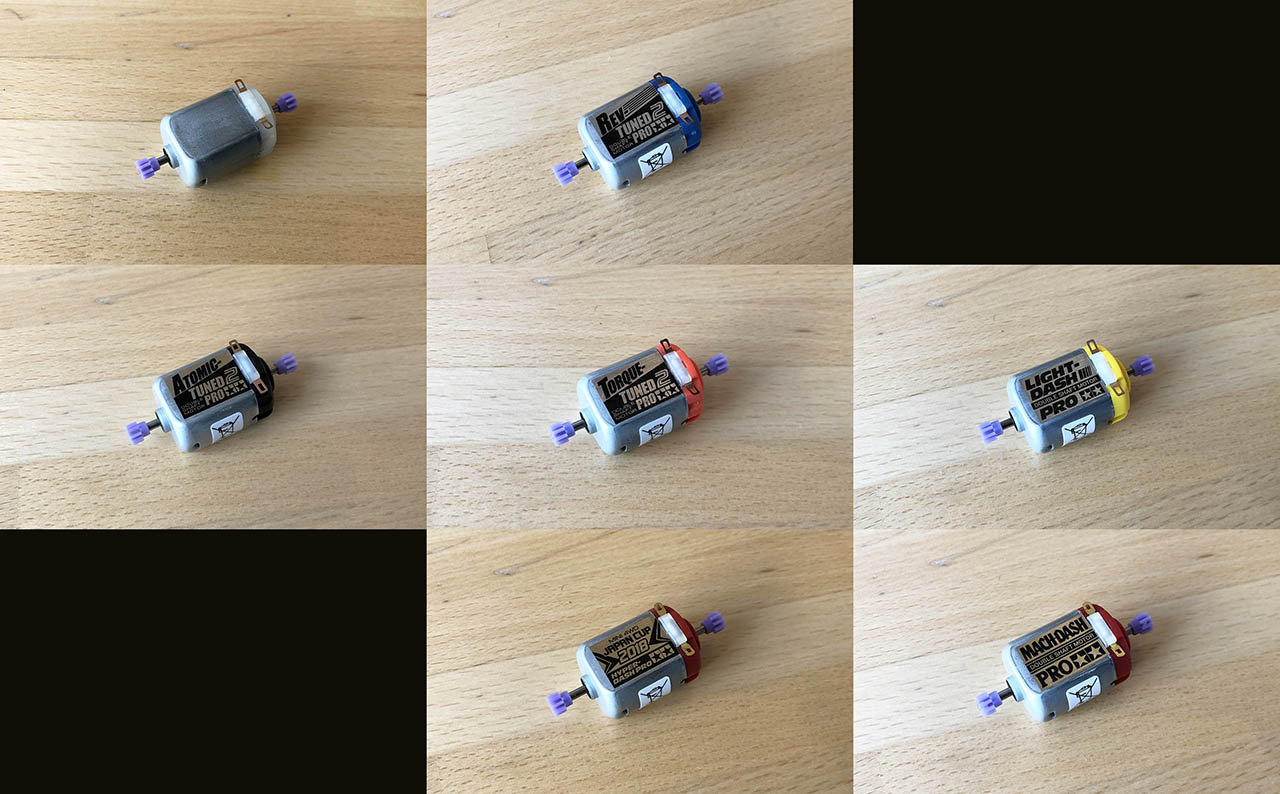
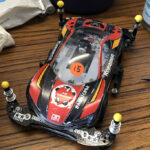
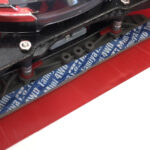
![7 different Tamiya Mini 4WD low profile small diameter tyres [Item no: 95208, 95205,95152, 95281, 95304]](https://www.mini4science.com/wp-content/uploads/2024/09/IMG_0538_mod2-150x150.jpg)
![8 different Tamiya Mini 4WD metal rollers [Item no: 95612, 15522, 95643, 95497, 15426, 95160, 15345, 15475]](https://www.mini4science.com/wp-content/uploads/2024/07/IMG_0296-150x150.jpg)
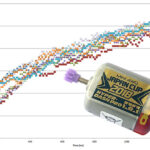
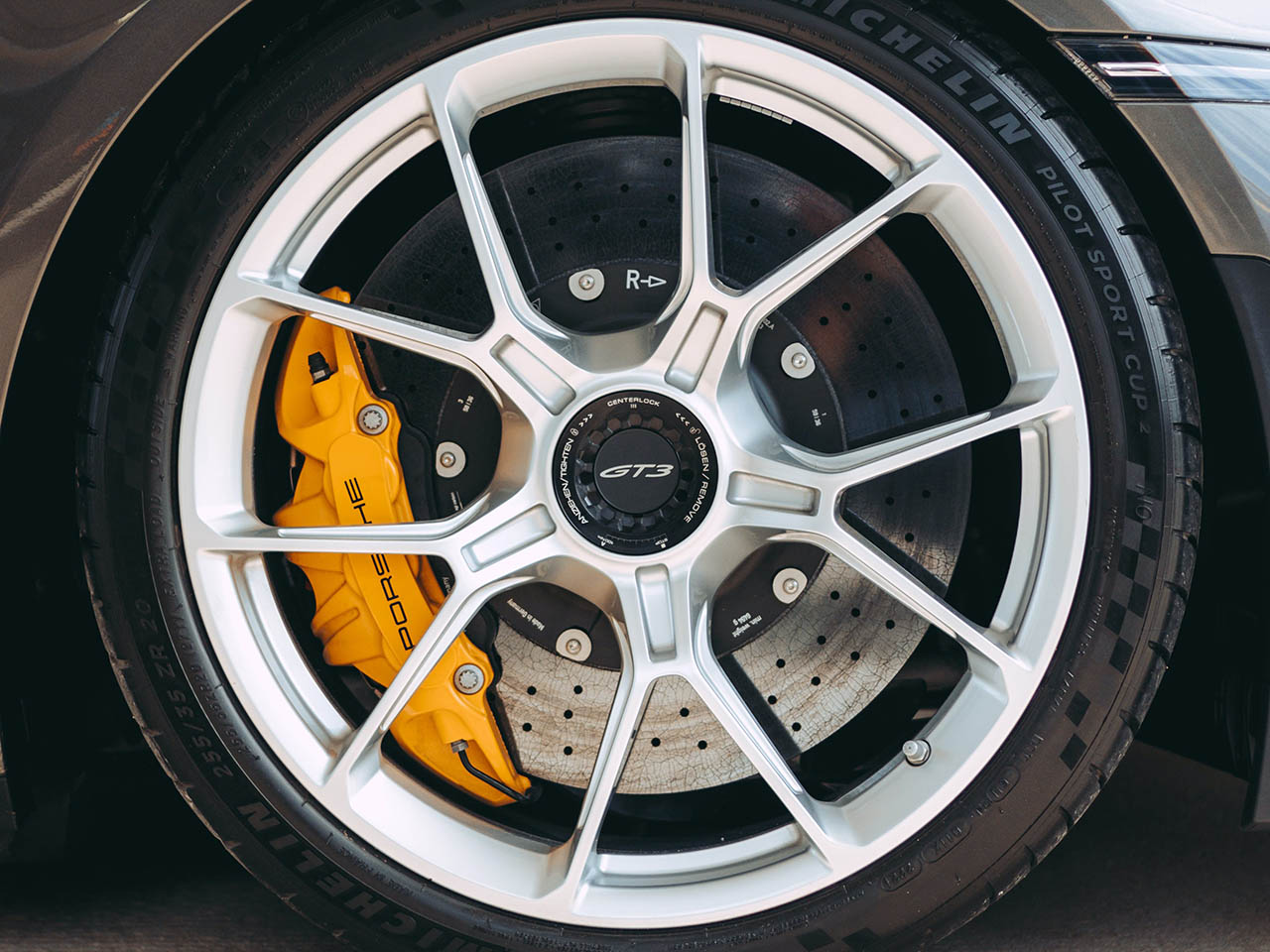
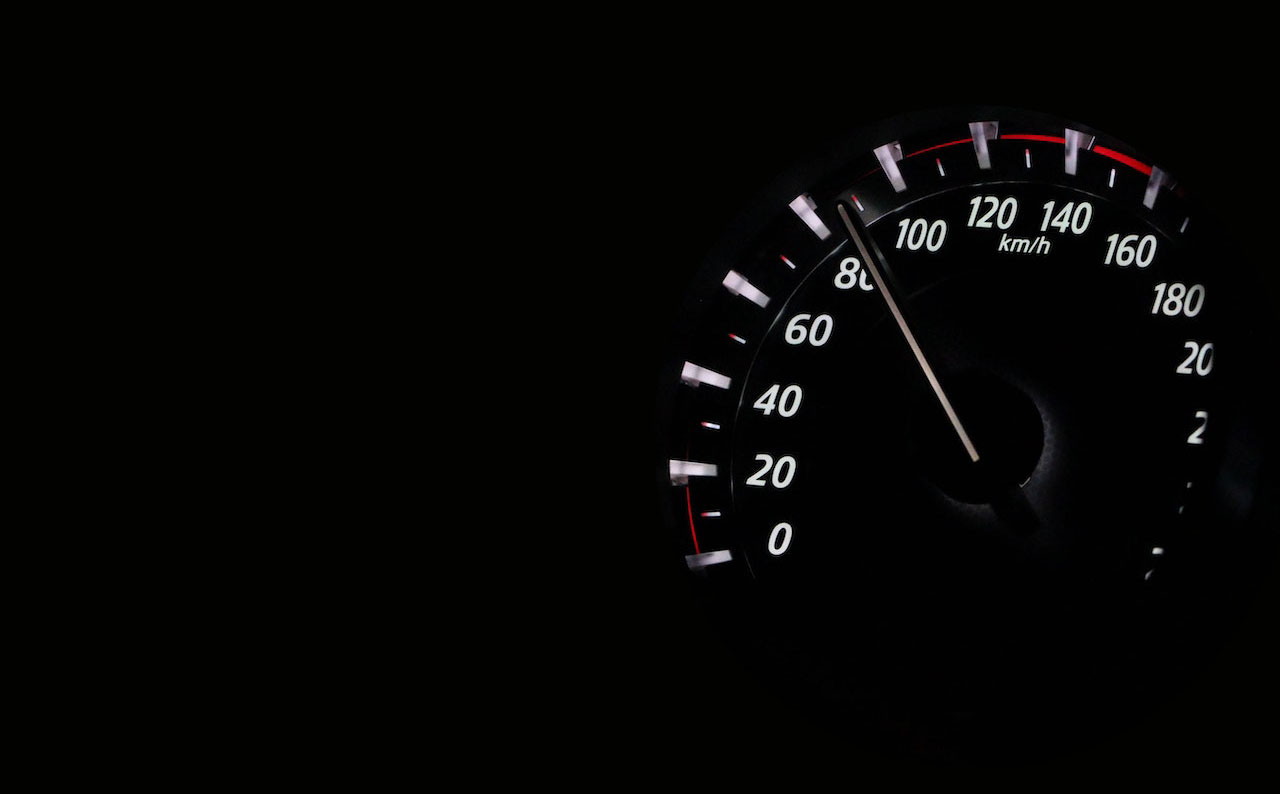
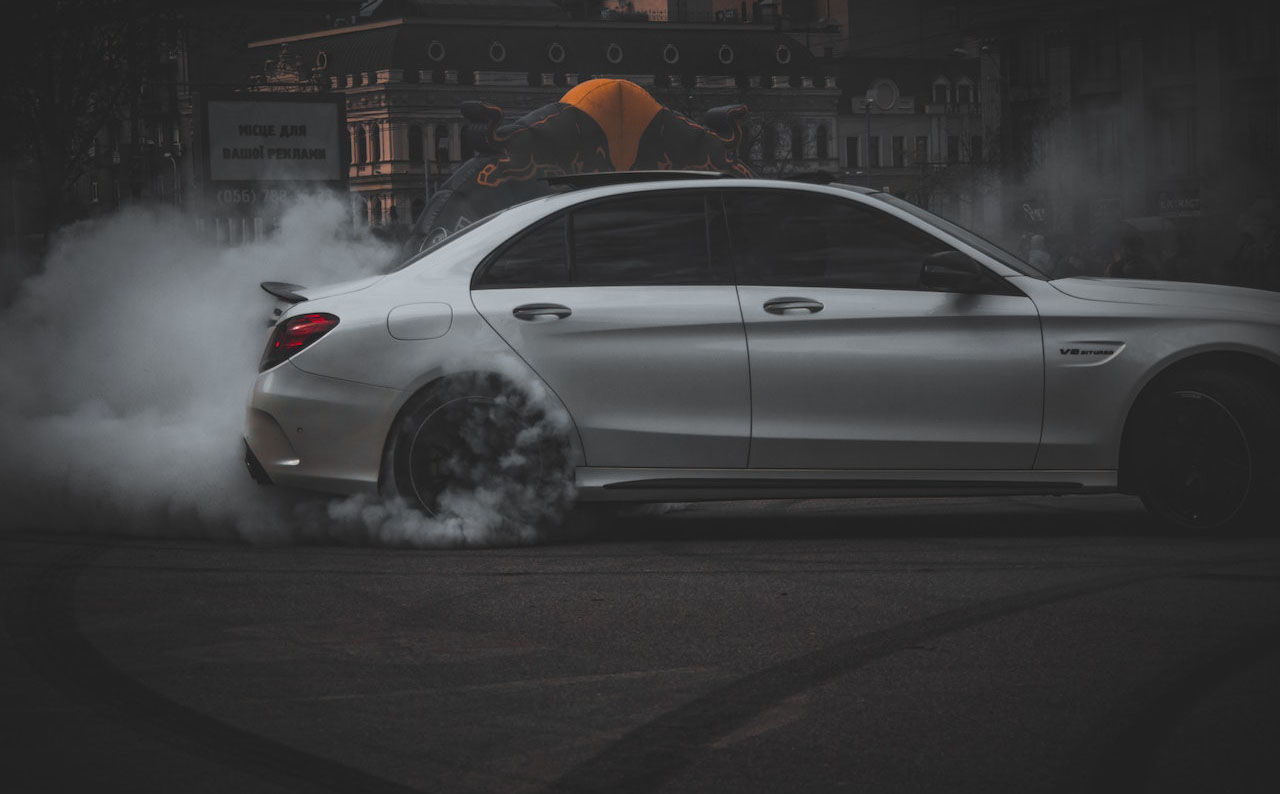
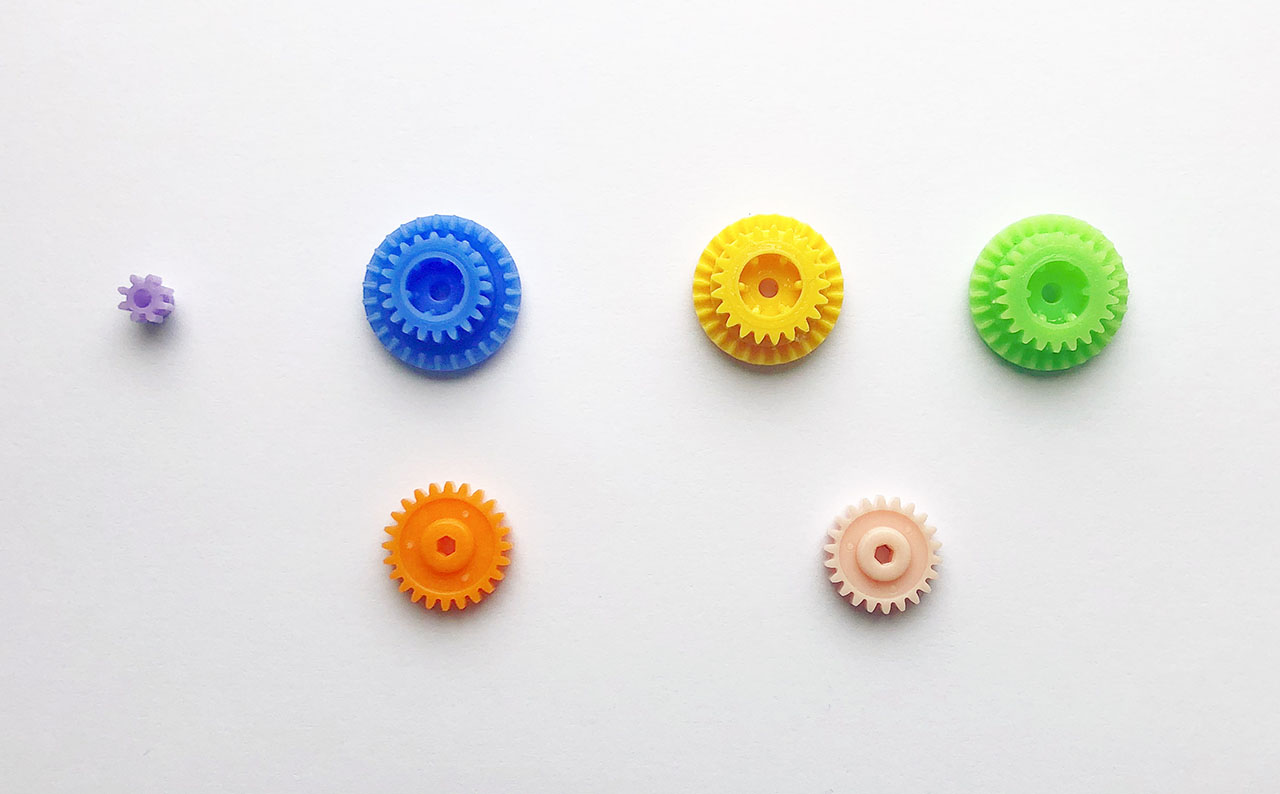
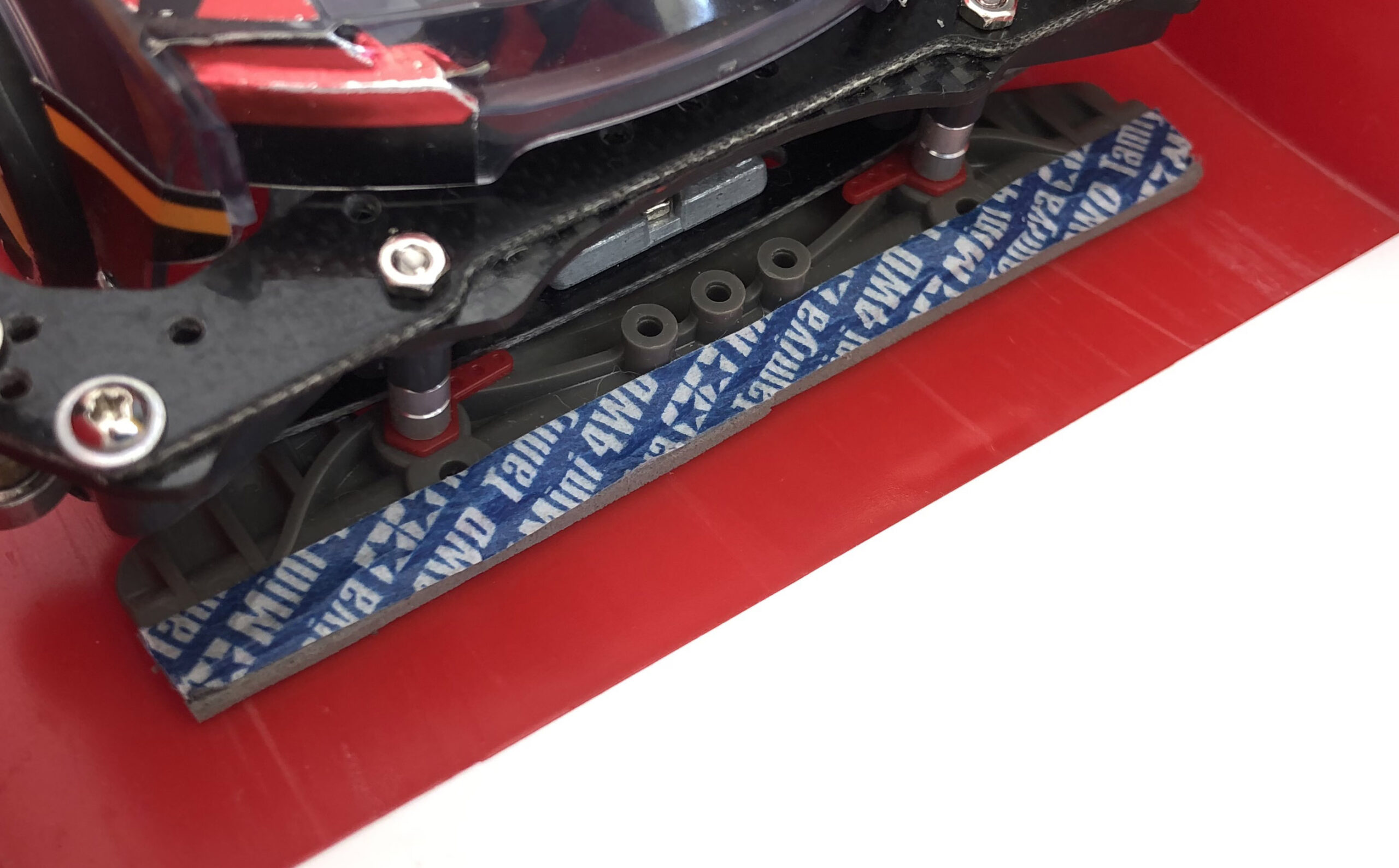
![7 different Tamiya Mini 4WD low profile small diameter tyres [Item no: 95208, 95205,95152, 95281, 95304]](https://www.mini4science.com/wp-content/uploads/2024/09/IMG_0538_mod2.jpg)
![8 different Tamiya Mini 4WD metal rollers [Item no: 95612, 15522, 95643, 95497, 15426, 95160, 15345, 15475]](https://www.mini4science.com/wp-content/uploads/2024/07/IMG_0296-scaled.jpg)
